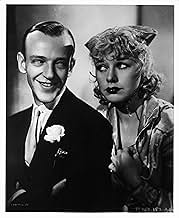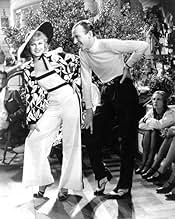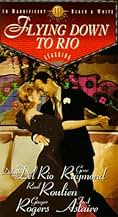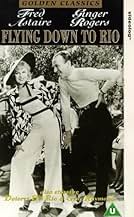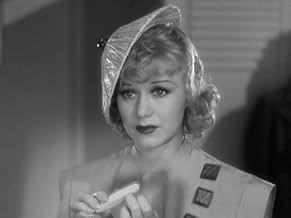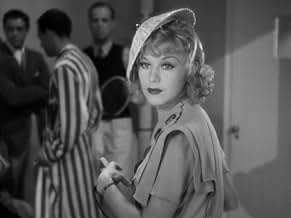IMDb-BEWERTUNG
6,6/10
4194
IHRE BEWERTUNG
Füge eine Handlung in deiner Sprache hinzuA bandleader woos a Latin flame who is already engaged to his employer.A bandleader woos a Latin flame who is already engaged to his employer.A bandleader woos a Latin flame who is already engaged to his employer.
- Für 1 Oscar nominiert
- 1 Gewinn & 2 Nominierungen insgesamt
Dolores Del Río
- Belinha De Rezende
- (as Dolores Del Rio)
Luis Alberni
- Rio Casino Manager
- (Nicht genannt)
Bernice Alstock
- Singer
- (Nicht genannt)
Chita Andrews
- Check Girl
- (Nicht genannt)
Empfohlene Bewertungen
If you watch "Flying Down to Rio" expecting it to be a Rogers and Astaire film, forget it - but it was their debut as a team, dancing the Carioca.
This is a 1933 movie short on plot and, as is often the case with the early talkies, a little slow in parts due to the pace of the dialogue. It is nevertheless a fun movie, with Astaire doing some wonderful solo dancing and of course, his dance with Ginger, which sent them on their way to movie history.
The stars of the film are Dolores Del Rio and Gene Raymond. After bandleader Raymond meets del Rio in the U. S., he ends up in Rio where he competes for her attentions with her fiancé Julio (Raul Roulien), his best friend.
The plot concerns the opening of a hotel in Rio and its planned takeover by another group. When the opening date is changed, the owner cannot get another performing license, so all seems to be lost.
Thus the number "Flying Down to Rio" with chorus girls doing maneuvers on the wings of flying planes. It's a spectacular part of the film, though in spots you can really see how fake it was. It doesn't really matter - it was early film-making where, without the use of computers, artistry and imagination were needed instead, and much was accomplished.
There are some interesting editing experiments noticeable as well, particularly during a big nightclub scene. It was precode, so some of the numbers are pretty darn steamy.
Dolores del Rio was surely one of the most stunningly beautiful women ever to appear on screen. Growing up, I remember seeing Sunday supplements with articles and photos about her current life - it was a good 30 years after this film - and her beauty remained awesome without the plastic surgery techniques available today. She was a true, fantastic beauty, and this film really showcases it.
This isn't the most wonderful musical you'll ever see but it's important nonetheless: It launched Rogers & Astairs, it's an interesting example of early editing, and it's precode. And if you watch it with the wonder that the depression audiences must have had, you'll enjoy it even more.
This is a 1933 movie short on plot and, as is often the case with the early talkies, a little slow in parts due to the pace of the dialogue. It is nevertheless a fun movie, with Astaire doing some wonderful solo dancing and of course, his dance with Ginger, which sent them on their way to movie history.
The stars of the film are Dolores Del Rio and Gene Raymond. After bandleader Raymond meets del Rio in the U. S., he ends up in Rio where he competes for her attentions with her fiancé Julio (Raul Roulien), his best friend.
The plot concerns the opening of a hotel in Rio and its planned takeover by another group. When the opening date is changed, the owner cannot get another performing license, so all seems to be lost.
Thus the number "Flying Down to Rio" with chorus girls doing maneuvers on the wings of flying planes. It's a spectacular part of the film, though in spots you can really see how fake it was. It doesn't really matter - it was early film-making where, without the use of computers, artistry and imagination were needed instead, and much was accomplished.
There are some interesting editing experiments noticeable as well, particularly during a big nightclub scene. It was precode, so some of the numbers are pretty darn steamy.
Dolores del Rio was surely one of the most stunningly beautiful women ever to appear on screen. Growing up, I remember seeing Sunday supplements with articles and photos about her current life - it was a good 30 years after this film - and her beauty remained awesome without the plastic surgery techniques available today. She was a true, fantastic beauty, and this film really showcases it.
This isn't the most wonderful musical you'll ever see but it's important nonetheless: It launched Rogers & Astairs, it's an interesting example of early editing, and it's precode. And if you watch it with the wonder that the depression audiences must have had, you'll enjoy it even more.
In Miami, during the presentation of the Yankee Clippers, the wolf band leader and pilot Roger Bond (Gene Raymond) flirts with the guest Belinha de Resende (Dolores Del Rio) and the stringent hotel manager fires them. However, the band is hired for the opening night of the Atlântico Hotel in Rio de Janeiro, and they need to fly to Brazil.
When Roger meets Belinha in the hall of the hotel, he learns that she lost her flight to Rio and he offers a ride for her in his plane. Roger is forced to land in an island and he immediately fixes the mechanical problem in the plane; however, he lies to Belinha and tells that he can not fix the problem just to spend the night alone with her. But Belinha, who is the fiancée of the Brazilian Júlio, resists to his harassment and later she finds another plane to fly to Rio.
Once in Rio, the infatuated Roger meets his friend Júlio without knowing that he is the fiancé of Belinha, and he tells about his love for the woman. When the Yankee Clippers are ready to open the hotel, powerful bankers that are interested to force the bankruptcy of the Atlântico's owner to take the hotel, send the police since he does not have the permit to anticipate the opening day. However, Roger's friend and musician Fred Ayres (Fred Astaire) proposes an airborne show to the guests. Meanwhile, the brokenhearted Roger decides to return to his country and leave Belinha with Júlio.
"Flying Down to Rio" is the debut of the pair Fred and Ginger in minor support roles. The sappy and naive romance has the Mexican Dolores Del Rio performing a Brazilian sassy woman and Gene Raymond in the lead roles. The footages from Rio de Janeiro in the 30's and the airborne show are the best moments of this film. The funniest thing in "Flying Down to Rio" is that there is no Brazilian actor or actress in the cast. My vote is six.
Title (Brazil): "Voando para o Rio" ("Flying to Rio")
When Roger meets Belinha in the hall of the hotel, he learns that she lost her flight to Rio and he offers a ride for her in his plane. Roger is forced to land in an island and he immediately fixes the mechanical problem in the plane; however, he lies to Belinha and tells that he can not fix the problem just to spend the night alone with her. But Belinha, who is the fiancée of the Brazilian Júlio, resists to his harassment and later she finds another plane to fly to Rio.
Once in Rio, the infatuated Roger meets his friend Júlio without knowing that he is the fiancé of Belinha, and he tells about his love for the woman. When the Yankee Clippers are ready to open the hotel, powerful bankers that are interested to force the bankruptcy of the Atlântico's owner to take the hotel, send the police since he does not have the permit to anticipate the opening day. However, Roger's friend and musician Fred Ayres (Fred Astaire) proposes an airborne show to the guests. Meanwhile, the brokenhearted Roger decides to return to his country and leave Belinha with Júlio.
"Flying Down to Rio" is the debut of the pair Fred and Ginger in minor support roles. The sappy and naive romance has the Mexican Dolores Del Rio performing a Brazilian sassy woman and Gene Raymond in the lead roles. The footages from Rio de Janeiro in the 30's and the airborne show are the best moments of this film. The funniest thing in "Flying Down to Rio" is that there is no Brazilian actor or actress in the cast. My vote is six.
Title (Brazil): "Voando para o Rio" ("Flying to Rio")
There was a golden age of cinema lasting only four or five years - from the end of the silent era to the beginning of the Hays Code, the severe censorship rules which sought to turn cinema from naughty to nice, but in actuality sapped them of their truth and energy.
`Flying Down to Rio' is a classic pre-Hayes code talkie, and its characters have a quality of frankness which endears them to modern audience far more than many later films, whose stilted, conservative quality is somewhat alienating. You'd be surprised at what they could get away with in those days - it would be forty years before a film could get away with a line like that spoken by a starlet of her South American rivals - `What have those girls got below the equator that we haven't got?'
The film, about a love triangle between a Brazilian woman and two members of a swing band, is of course famous for two things - the slightly surreal sequence in which showgirls ride a biplane down to Rio in Busby Berkley-esque formation, and the debut of Fred Astaire and Ginger Rogers as a screen team. It's no wonder that audiences fell in love with the duo, whose `Carioca' is the highlight of the film.
They only made them like this for a little while - more's the shame!
`Flying Down to Rio' is a classic pre-Hayes code talkie, and its characters have a quality of frankness which endears them to modern audience far more than many later films, whose stilted, conservative quality is somewhat alienating. You'd be surprised at what they could get away with in those days - it would be forty years before a film could get away with a line like that spoken by a starlet of her South American rivals - `What have those girls got below the equator that we haven't got?'
The film, about a love triangle between a Brazilian woman and two members of a swing band, is of course famous for two things - the slightly surreal sequence in which showgirls ride a biplane down to Rio in Busby Berkley-esque formation, and the debut of Fred Astaire and Ginger Rogers as a screen team. It's no wonder that audiences fell in love with the duo, whose `Carioca' is the highlight of the film.
They only made them like this for a little while - more's the shame!
I gave this "Fred Astaire" comedy-romance-musical higher marks than normal because the romance, usually the sappy part of the Astaire films, doesn't dominate as it does most of his movies.
As usual, there are a number of interesting dance scenes including a spectacular Busby Berkeley-type production on the wings of airplanes. That scene has to be seen to be believed, not just for the uniqueness of it but for the bra-less women pictured! Yikes, it's not something you expect to see with a classic film - and you wouldn't see for another 35 years. It's pretty amazing.
I really shouldn't label this an "Astaire film " because Dolores Del Rio and Gene Raymond are the two stars. Astaire is a close third. Raul Roulien would be next while Ginger Rogers just has a small role.....but it IS noteworthy for being the first time all of us saw the famous Astaire-Rogers pairing.
The comedy in this film also is pretty good. The best parts of the film are the beginning and end. The fadeout segways in here reminded of silent films, which weren't that long removed from this.
As usual, there are a number of interesting dance scenes including a spectacular Busby Berkeley-type production on the wings of airplanes. That scene has to be seen to be believed, not just for the uniqueness of it but for the bra-less women pictured! Yikes, it's not something you expect to see with a classic film - and you wouldn't see for another 35 years. It's pretty amazing.
I really shouldn't label this an "Astaire film " because Dolores Del Rio and Gene Raymond are the two stars. Astaire is a close third. Raul Roulien would be next while Ginger Rogers just has a small role.....but it IS noteworthy for being the first time all of us saw the famous Astaire-Rogers pairing.
The comedy in this film also is pretty good. The best parts of the film are the beginning and end. The fadeout segways in here reminded of silent films, which weren't that long removed from this.
By the time Flying Down to Rio was released in 1933, It was Warner Brothers who had been having the success as far as musicals were concerned.
Ruby Keeler and Dick Powell were the uncrowned King and Queen of song and dance land and in films like 42nd Street, Footlight Parade and Gold Diggers and the later movies Dames and Flirtation Walk they were paving the way for a motion picture genre that would continue in much the same vein for the next twenty years.
With kaleidescope routines expertly directed by Busby Berkeley via overhead cameras, the movie musical was finally taking shape bearing little or no resemblance to earlier dismal efforts like MGM'S Broadway Melody of 1929 or their equally unimpressive Hollywood Review from the same year.
RKO was at the time a struggling studio with huge debts and was on the verge of going bankrupt. However they decided to capitalize on this medium in an effort to pull themselves back into the black.
Flying Down to Rio was in all respects no different to any other of the films they produced at the time and I'm sure this film would have sank into obscurity and be long forgotten had it not been for the movie milestone it boasts.
Fred Astaire and Ginger Rogers were cast as only 3rd and 4th billed performers, to all intents and purposes, the token dance act, a novelty. Neither of them had done much before. Ginger of course was beginning to make a name for herself. She had featured in both the fore-mentioned 42nd Street and Gold Diggers and was slowly working her way out of chorus lines into bit parts and the occasional solo number.
Fred had done less still. Already a well known stage star in America and Britain, he had just one previous film under his belt. A natural dancer of extraordinary talent, Fred was signed on as RKO's secret weapon in their efforts to make the best musicals.
However, no matter how dull the storyline to "Rio" is (and it is believe me) it is soon forgotten when Fred and Ginger perform their first ever screen dance, The Carioca, a musical number with Latin- American tempo complete with stunning costumes, guest singers and the very kaleidoscopic shots of which Busby Berkeley himself would have been proud. It is their only dance together in the film and their actual dancing is given very limited screen-time, but it was enough to cause Astaire/Rogers mania.
Forgive the cliche but the rest is history as they say.
So successful were they that they went on to appear in a further nine films together making them one of the most beloved and cherished screen partnerships ever.
Alone the Astaire/Rogers musicals of the thirties saved the studio from closure and they helped push Warner's, Keeler and Powell into second place, at least as far as musicals were concerned.
Astaire is given further opportunity to shine in two stunning solos which will leave the viewer in no doubt whatsoever why he was the very best at his chosen craft.
Complete with the now famous 'girls-strapped-onto-aeroplane-wings' scene and with the added talents of Delores Del Rio and Gene Raymond adding the romance, It all helps to make an otherwise dull film into a legendary silver screen gem.
Ruby Keeler and Dick Powell were the uncrowned King and Queen of song and dance land and in films like 42nd Street, Footlight Parade and Gold Diggers and the later movies Dames and Flirtation Walk they were paving the way for a motion picture genre that would continue in much the same vein for the next twenty years.
With kaleidescope routines expertly directed by Busby Berkeley via overhead cameras, the movie musical was finally taking shape bearing little or no resemblance to earlier dismal efforts like MGM'S Broadway Melody of 1929 or their equally unimpressive Hollywood Review from the same year.
RKO was at the time a struggling studio with huge debts and was on the verge of going bankrupt. However they decided to capitalize on this medium in an effort to pull themselves back into the black.
Flying Down to Rio was in all respects no different to any other of the films they produced at the time and I'm sure this film would have sank into obscurity and be long forgotten had it not been for the movie milestone it boasts.
Fred Astaire and Ginger Rogers were cast as only 3rd and 4th billed performers, to all intents and purposes, the token dance act, a novelty. Neither of them had done much before. Ginger of course was beginning to make a name for herself. She had featured in both the fore-mentioned 42nd Street and Gold Diggers and was slowly working her way out of chorus lines into bit parts and the occasional solo number.
Fred had done less still. Already a well known stage star in America and Britain, he had just one previous film under his belt. A natural dancer of extraordinary talent, Fred was signed on as RKO's secret weapon in their efforts to make the best musicals.
However, no matter how dull the storyline to "Rio" is (and it is believe me) it is soon forgotten when Fred and Ginger perform their first ever screen dance, The Carioca, a musical number with Latin- American tempo complete with stunning costumes, guest singers and the very kaleidoscopic shots of which Busby Berkeley himself would have been proud. It is their only dance together in the film and their actual dancing is given very limited screen-time, but it was enough to cause Astaire/Rogers mania.
Forgive the cliche but the rest is history as they say.
So successful were they that they went on to appear in a further nine films together making them one of the most beloved and cherished screen partnerships ever.
Alone the Astaire/Rogers musicals of the thirties saved the studio from closure and they helped push Warner's, Keeler and Powell into second place, at least as far as musicals were concerned.
Astaire is given further opportunity to shine in two stunning solos which will leave the viewer in no doubt whatsoever why he was the very best at his chosen craft.
Complete with the now famous 'girls-strapped-onto-aeroplane-wings' scene and with the added talents of Delores Del Rio and Gene Raymond adding the romance, It all helps to make an otherwise dull film into a legendary silver screen gem.
Wusstest du schon
- WissenswertesStanding outside a bakery shop in Rio, Ginger Rogers asks, "Oh, Freddie, how do you ask for little tarts in Portuguese?" Fred Astaire replies, "Don't heckle me, try the Culbertson System." This pre-Code, double entendre joke would have been funny to Depression-era audiences, for whom bridge was a common pastime. Ely Culbertson was a champion bridge player and worldwide celebrity, who had won several international tournaments by developing a rather aggressive bidding system. He was also notorious for his sexual exploits. His 1940 autobiography was banned in many countries. In the 1930s, the word "tart" was equivalent to "slut" or "whore". Also, in the opening inspection of hotel staff, the boss sees a maid whose shoe heels are oddly beveled and says he will not tolerate that sort of thing. A "round-heeled woman" was 1930s slang for a prostitute, a woman who could tilt easily from standing to being on her back.
- PatzerFrom the height they were flying, most of the "dance" routines of the young women on the plane wings would not be visible to people on the ground.
While true, this observation is not a Goof. The purpose of the event likely was more for advertising or Newsreel value, or even simply "bragging rights".
- Zitate
Belinha's Friend: What have these South Americans got below the equator that we haven't?
- VerbindungenFeatured in Hollywood and the Stars: The Fabulous Musicals (1963)
- SoundtracksMusic Makes Me
(1933) (uncredited)
Music by Vincent Youmans
Lyrics by Gus Kahn and Edward Eliscu
Performed by Ginger Rogers
Top-Auswahl
Melde dich zum Bewerten an und greife auf die Watchlist für personalisierte Empfehlungen zu.
- How long is Flying Down to Rio?Powered by Alexa
Details
Box Office
- Budget
- 462.000 $ (geschätzt)
- Laufzeit1 Stunde 29 Minuten
- Farbe
- Seitenverhältnis
- 1.37 : 1
Zu dieser Seite beitragen
Bearbeitung vorschlagen oder fehlenden Inhalt hinzufügen

Oberste Lücke
By what name was Flying Down to Rio (1933) officially released in India in English?
Antwort

